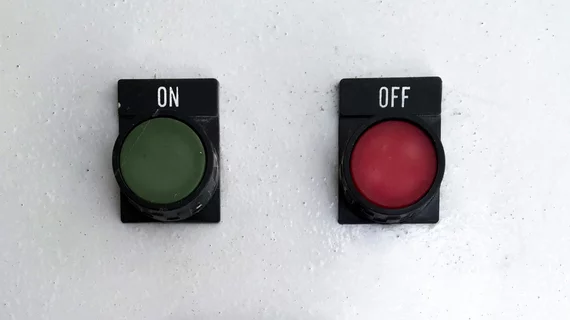Why some CT equipment should be powered down more often
Powering down dual energy computed tomography (DECT) scanners can significantly reduce energy consumption in as little as two minutes, according to new data published in Academic Radiology.
Radiology’s role in energy consumption has sparked numerous initiatives to reduce the industry’s carbon footprint in recent years. Imaging systems have been a primary target of these initiatives.
“Besides surgery, anesthesia or intensive care, radiology departments play a major role in a hospital’s energy consumption,” corresponding author Niemann Tilo, MD, with the department of radiology at Kantonal Hospital Baden in Switzerland, and colleagues explain. “Large diagnostic devices such as CT and MRI scanners notably contribute to the overall energy footprint of hospitals.”
DECT scanners have been growing in popularity due to the enhanced imaging capabilities they offer. However, the amount of energy they consume, both while in use and when in an idle mode, is significant.
To determine the most efficient means of reducing the energy consumption of DECT imaging, researchers analyzed three different scanners—one dual source and two single source. The team looked at how much energy could be saved when scanners sat idle, in low power mode or when turned off completely.
At baseline, mean energy consumption when scanners were idle was calculated at 2.6 kilowatt-hours (kWh) ± 1.34 kWh; when in low-power mode, it was 0.89 kWh ± 0.42 kWh, and when turned off completely it was less than 0.01 kWh ± 0.003 kWh.
Compared to an idle state, the group estimated that switching scanners to low-power mode when not in use would save approximately 3,767 kg of carbon dioxide emissions per year, while shutting scanners down would save 5,868 kg of CO2 annually.
For low-power mode, energy is saved after just five minutes. It takes less than half of that amount—two minutes—when systems are shut down.
The authors argue that their findings suggest powering down equipment during times of reduced use, not just on nights and weekends, is worth considering in departments with multiple scanners.
“The focus of shutdown management should not be limited solely to night or weekend shifts. It is the first time that comprehensive analysis conducted a time range within which shutdown proves sufficient,” the group notes. “This suggests that even short nonutilization periods of less than one hour may be suitable for CT shutdown.”
The study abstract can be found here.

